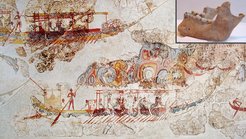Ancient Peoples-Modern Names: Reconciling material cultures in archaeology with the new archaeogenetic data
A new study in Scientific Reports addresses the fundamental issue of identifying and naming genetic clusters in the new field of archaeogenetics. The first joint publication of the Max Planck – Harvard Research Center for the Archaeoscience of the Ancient Mediterranean lays the groundwork for resolving misunderstandings in the classification of ever growing libraries of ancient genetic data. (September 2018)

Ancient DNA analysis is a powerful new tool for investigating the human past that is transforming the traditional disciplines like archaeology and history. This new study tackles one of the fundamental obstacles in the collaboration between archaeogeneticists and archaeologists: the development of a common language for archaeological phenomena.
Recent methodological advances in the field of ancient DNA analysis have exponentially increased the number of ancient genomes published. This data can be analyzed to identify statistical groupings of individuals who share more genetic variants with each other. To name these “genetic clusters,” geneticists have frequently borrowed names from archaeological groupings, without considering the historically problematic nature of the concept of cultures and identities in archaeology. This has led to the misinterpretation of the genetic results in subsequent papers and by the public, or even a rejection of ancient DNA studies as a whole in parts of the archaeological community.
The nature of names is that they have or rather convey meanings. What we call a thing inevitably influences what we think it is. Naming is thus a double-edged sword that can to the same extent prevent and stir misunderstandings.
To address these issues the paper focuses on two aspects: 1. It explains the concept of “genetic clusters” in contrast to “archaeological cultures.” 2. It discusses naming conventions used in recent genetic publications and introduces two future possibilities for the nomenclature of genetic clusters: a system based exclusively on the combination of geographical terms and relative dates (e.g. Levant Middle Bronze Age), and a mixed nomenclature that additionally uses names of archaeological cultures (e.g. Yamnaya) and subsistence practices (like hunter-gatherer). The authors of the paper lay the groundwork for debate establishing a wider theoretical framework that allows more careful integration of genetic research into ancient studies.
